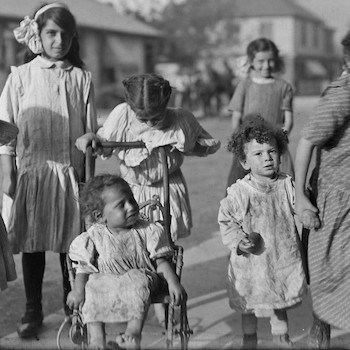Ring Around the Maple: Settler Childhoods in English Canada, 1850 to 1975 (Cynthia Comacchio - Publics and Social Justice)
Dr. Cynthia Comacchio is a member of the LCSC Publics and Social Justice and War and Society collectives. Her research focuses on the history of children/childhood and youth in Canada in the late 19th to 21st centuries
My current project, Ring Around the Maple: Settler Childhoods in English Canada, 1850 to 1975 (to be published by WLU Press), has a lengthy and complicated history itself. It began when Neil Sutherland, a key scholar in the history of children and childhood in settler Canada, began what was to be a synthesis/overview of those histories some fifteen years ago. Poor health kept him from doing much more than outlining a rough draft, but he invited me to take on the project. We consulted regularly as Neil’s health deteriorated; to my tremendous regret, he left this earth before I could complete it. Without his intellectual energy, his knowledge, and his generous mentorship, this project would not be. I consider it very much a co-authored work that will be published as such as a tribute to him.
This book is about the historic centrality of children, and the historic significance of childhood, in all its complexities: the transmuting, twirling, skipping, dance around the maple, to extend the title metaphor. Our purpose was to trace the lives of Canadian children over the “long century,” roughly from the late Victorian years to the eve of the new millennium, as these have been examined in the rich, historical, interdisciplinary, often multi-disciplinary literature on Canadian children that has developed since the 1970s. As practitioners in the subject area, we could not resist integrating into this synthesis our own research, published and unpublished. During the writing process, we have seen some major paradigm shifts in approach and methodology that have compelled us to remake it (several times!) along the way. We begin by underlining an obvious point: we cannot tell the story of allCanadian children. This would be a laughably naïve and ambitious— actually imperialist—objective. We do not aspire to put forward any outmoded and untenable argument about “a Canadian childhood” or “the Canadian child” to override the diverse Indigenous, Francophone, regional, cultural and social identities that have always made up the nation-state. This project is consequently focused on the Settler side of the past, though this would be a very small category if we were to interpret it strictly and omit the children of immigrants and racialized individuals. “Settler” is encompassing only insofar as it recognizes the presumed racial hierarchy that was employed in the colonial project.
Despite all necessary and acknowledged limitations, we have tried to animate this historical overview by emphasizing whatever we could garner of the “child’s-eye” perspective. We have examined life-writings, including diaries and correspondence, memoirs, interviews, oral histories and autobiographies, unpublished, self-published, published by ephemeral local presses, or more recently (and thankfully, given the Covid restrictions on travel and archival research) digitized for internet access. We have examined photographs, catalogues, advertisements, musical recordings, radio and TV shows, children’s literature, the popular press, schoolbooks and religious texts, films and other such visual and aural testimony. We have searched out the most coveted and scarce of all testimonies, children’s own writings. As much as we have striven to find the voices of the marginalized, the source base, as always, favours the more affluent, white, urban Euro-Canadian children, those deemed “normal” in terms of their mental and physical abilities, attitudes and behaviours, within the context of their times. Throughout this period, as now, the “other” children appear largely in adult discourses about their “problems” and are regularly cast as “problem children” in and of themselves.
Childhood is the universal first step into history. Children are shaped by the historical moment into which they are born; they represent historic trends and ideals, domestic and global; more often than adults acknowledge, they make history. Effectively barometers gauging the sociohistoric environment, children embody the future envisioned by adults who share their moment. In a nation seemingly constantly challenged to conceptualize its own identity—a nation, like its children, struggling toward selfhood--the conditions in which Canadian children of the past grew up disclose much about the Canada that was, is, and aspires to be. This is what Neil Sutherland set out to capture, and what I have tried to do in this figurative “ring around the maple”: to consider children and childhood in the past in a continuous whirl set to the rhymes and rhythms of children’s inclinations, as well as those of time and place.
